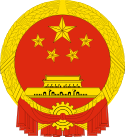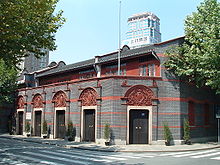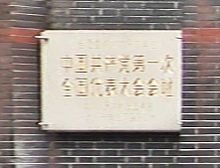- National Congress of the Communist Party of China
-
People's Republic of China 
This article is part of the series:
Politics and government of
the People's Republic of ChinaIdeology- Leadership of China
- Constitutional history
- National Congress
- National People's Congress
- NPC Standing Committee
- President: Hu Jintao
- State Council (Central People's Government)
- Premier: Wen Jiabao
- Vice Premiers
- 1st ranking: Li Keqiang
- State Councilors
- Vice Premiers
- Premier: Wen Jiabao
- PRC Central Military Commission
- Supreme People's Court
- President: Wang Shengjun
- Supreme People's Procuratorate
- Procurator-General: Cao Jianming
- Political Consultative Conference
- National Committee
- Minor political parties
Other issues
The National Congress of the Communist Party of China (simplified Chinese: 中国共产党全国代表大会; traditional Chinese: 中國共產黨全國代表大會; pinyin: Zhōngguó Gòngchǎndǎng Quánguó Dàibiǎo Dàhuì; literally: Chinese Communist Party National Representatives Congress) is a party congress that is held about once every five years. The National Congress is theoretically the highest body within the Communist Party of China, but in practice important decisions are made before the meeting. Since 1987 the National Congress has always been held in the months of October or November. The venue for the event, beginning in 1956, has always been the Great Hall of the People in Beijing. In the past two decades the National Congress of the CPC has been pivotal at least as a symbolic part of leadership changes in the People's Republic of China, and therefore has gained international media attention.
Contents
Overview
The National CPC Congress should not be confused with the National People's Congress which is the legislature of the People's Republic of China. In contrast with the NPC which has become more assertive since the 1990s, the National Congress of the Communist Party has shown no signs of becoming a deliberative assembly with independent power. In addition the National Congress should not be confused with the Chinese People's Political Consultative Conference. While leadership changes in the government usually occur at the National People's Congress sessions, now held every March, leadership changes in the party occur at the Party's National Congress.
Since the mid-1980s, the Communist Party has attempted to maintain a smooth and orderly succession and avoiding a cult of personality, by having a major shift in personnel every ten years in even number party congresses, and by promoting people in preparation for this shift in odd number party congresses.
In addition, as people at the top level of the party retire, there is room for younger members of the party to move up one level. Hence the party congress is a time of a general personnel reshuffle, and the climax of negotiations that involve not only the top leadership but practically all significant political positions in China. Because of the pyramid structure of the party and the existence of mandatory retirement ages, cadres who are not promoted at a party congress are likely to face the end of their political careers.
In addition to making leadership changes, the Congress also reviews and changes, if necessary, the Party's Constitution, and selects the Central Committee, a powerful decision making body. Each five-year cycle of the National People's Congress also has a series of plenums of the Central Committee which since the mid-1990s have been held more or less regularly once every year.
Since the establishment of PRC, the Congresses have occurred approximately every five years and since 1956, they have always taken place in the capital, Beijing. Each Party Congress lasted for five to ten days. Unlike Central Committee meetings which have on occasion been the focus of shifts in Party policy, Congresses have been occasions in which personnel decisions made beforehand have been announced, and ideologies and doctrines which have already been introduced are entrenched into the Party Constitution.
Each Congress's name is abbreviated in Chinese as the number of the Conference, followed by character da (大), short for dahui (大会 "conference"). For example, the sixteenth Conference, Zhōnguó Gòngchǎndǎng Dìshíliùcì Quánguó Dàibiǎo Dàhuì (simplified Chinese: 中国共产党第十六次全国代表大会; traditional Chinese: 中國共產黨第十六次全國代表大會), is shortened to Shíliù Dà (十六大 "sixteenth da").
Similar to the practice of the NPC, the delegates to the Congress are formally selected from grassroot party organizations, and like the NPC, the system of staggered elections in which one level of the party votes for the delegates to the next higher level allows the party center to control the election of delegates.
Chronology of Congresses
Before founding of People's Republic
- 1st Congress (Yi da) (一大)
- Date: July 23–31, 1921
 Location of 1st Congress (Xingye Road, Shanghai).
Location of 1st Congress (Xingye Road, Shanghai).
 Memorial plaque at the Museum of the First National Congress of the Chinese Communist Party.
Memorial plaque at the Museum of the First National Congress of the Chinese Communist Party.
-
-
- Delegates: 12
- Party members: 50
- Significance: The first platform (綱領) of the Party passed; Mao Zedong attends (as Hunan representative); Zhang Guotao acts as top party official; Chen Duxiu becomes first leader of CPC "Secretariat"; attended by two Comintern representatives (during Shanghai meetings).
-
- 2nd Congress (Er Da) (二大)
- Date: July 16–23, 1922
- Location: Shanghai
- Participants
-
- Delegates: 12
- Represented party members: 195
- Significance: Mao Zedong absent from Congress; Party continues purging anarchists, tries to maintain an independent stance from Sun Yat-Sen's Kuomintang (KMT).
- 3rd Congress (San Da) (三大)
- Date: June 12–20, 1923
- Location: Guangzhou
- Participants
-
- Delegates: ~30
- Represented party members: 420
- Significance: CPC formally ratifies the "bloc within" strategy of cooperation with the KMT as demanded by the Comintern.
- 4th Congress (Si Da) (四大)
- Date: January 11–22, 1925
- Location: Shanghai
- Participants
-
- Delegates: 20
- Represented party members: 994
- Significance: CPC Party Center continues efforts to bring semi-independent regional Party branches under its control.
- 5th Congress (Wu Da) (五大)
- Date: April 27-May 9, 1927
- Location: Wuhan
- Participants
-
- Delegates: ~80
- Represented party members: 57,967
- Significance: Congress followed Chiang Kai-shek's crackdown on Communists in Shanghai and elsewhere; CPC continues to "support the KMT Left and oppose the KMT Right".
- 6th Congress (Liu Da) (六大)
- Date: June 18-July 11, 1928
- Location: Moscow
- Participants
-
- Delegates: 84
- Alternate delegates: 34
- Represented party members: ~40,000
- Significance: First and only Party Congress held outside China (due to Chiang's anti-CPC crackdown); sanctioned creating armed forces controlled by CPC but still to be used "under the KMT flag."; Mao Zedong absent, stays in China at the CCP's Jinggangshan base.
- 7th Congress (Qi Da) (七大)
-
- Delegates: 544
- Alternate delegates: 208
- Represented party members: 1.21 million
- Significance: Party constitution (黨章) is passed; National flag designed(?); CPC "Chairman" Mao Zedong is named undisputed leader of CPC; Mao's "thought" enshrined in CPC Party Constitution for first time; Mao retells the fable of "the old fool who moves a mountain" (愚公移山) in his closing address.
-
After 1949
- 8th Congress (Ba Da) (八大)
- Date: September 15–27, 1956
- Location: Beijing
- Participants
-
- Delegates: 1,026
- Alternate delegates: 107
- Represented party members: 10,730,000
- Significance: first Congress to be held in 11 years; Mao Zedong Thought is taken out of CPC Party Constitution; Party technocrats Liu Shaoqi and Deng Xiaoping assume higher profiles.
- 9th Congress (Jiu Da) (九大)
- Date: April 1–24, 1969
- Location: Beijing
- Participants
-
- Delegates: 1,512
- Represented party members: 22,000,000
- Significance: Held at the culmination of the "Great Proletarian Cultural Revolution," Mao's Party is decimated from infighting; People's Liberation Army (PLA) influence on Party administration pronounced; few members appointed to power during the previous Party Congress survive the 9th Congress politically; former State Chairman and second-ranking Liu Shaoqi (arrested 1966) and former CPC General Secretary Deng Xiaoping labelled "traitorous scabs and renegades"; Defence Minister Lin Biao becomes CPC Vice Chairman and Mao's "closest comrade-in-arms", and is designated constitutionally as Mao's successor; Mao's "thought" reinserted into CPC Party Constitution.
- 10th Congress (Shi Da) (十大)
- Date: August 24–28, 1973
- Location: Beijing
- Participants
-
- Delegates: 1,249
- Represented party members: 28,000,000
- Significance: "Gang of Four" led by Mao's wife Jiang Qing reach paramount power; first CPC Congress after US President Richard Nixon's visit to PRC.
- 11th Congress (Shiyi Da) (十一大)
- Date: August 12–18, 1977
- Location: Beijing
- Participants
-
- Delegates: 1,510
- Represented party members: 35,000,000
- Significance: first Party Congress following Mao's death and after the fall of the Gang of Four; Deng Xiaoping reinstated to all of his previous posts.
- 12th Congress (Shi'er Da) (十二大)
- Date: September 1–11, 1982
- Location: Beijing
- Participants
-
- Delegates: 1,600
- Alternate delegates: 149
- Represented party members: 39,650,000
- Significance: Central Advisory Commission (CAC, 中央顾问委员会), and Central Discipline Inspection Commission (中央紀律檢查委員會) were created; CPC Party Chair position abolished, CPC General Secretary position becomes (on paper) paramount position; former CPC leader Hua Guofeng loses formal power (except his Central Committee membership) as Hu Yaobang, not Hua, gives keynote Party address.
- 13th Congress (Shisan Da) (十三大)
- Date: October 25-November 1, 1987
- Location: Beijing
- Participants
-
- Full delegates: 1,936
- Specially invited delegates: 61
- Represented party members: 46,000,000
- Significance: Deng Xiaoping and all other "Second Generation" CPC leaders retire from active positions in the Party (again, on paper); "Third Generation" members (led by Zhao Ziyang) dominate the CPC Politburo Standing Committee.
- 14th Congress (Shisi Da) (十四大)
- Date: October 12–18, 1992
- Location: Beijing
- Participants
-
- Full delegates: 1,989
- Specially invited delegates: 46
- Represented party members: 51,000,000
- Significance: first Party Congress after the Tiananmen Square protests of April–June 1989 and the violent crackdown of 3–4 June 1989; Jiang Zemin's position as CPC General Secretary, Chairman of the (CPC) Central Military Commission ratified; Hu Jintao makes first appearance on Politburo Standing Committee.
- 15th Congress (Shiwu Da) (十五大)
- Date: September 12–18, 1997
- Location: Beijing
- Participants
-
- Full delegates: 2,074
- Specially invited delegates: 60
- Represented party members: 59,900,000
- Significance: first Party Congress following death of Deng Xiaoping and the reversion of Hong Kong to China on 1 July 1997; Jiang Zemin forces party rival Qiao Shi to retire; Inclusion of Deng Xiaoping's philosophy into Party constitution.; Jiang Zemin announced plans to sell, merge, or close the vast majority of SOEs in a program which included some privatization.
- 16th Congress (Shiliu Da) (十六大)
- Date: November 8–15, 2002
- Location: Beijing
- Participants
-
- Full delegates: 2,114
- Specially invited delegates: 40
- Represented party members: 66,000,000
- Significance: Hu Jintao elected General Secretary; "Fourth Generation" of CPC leadership assumes control of the Party and the country; Jiang Zemin packs the CPC Politburo Standing Committee with supporters, holds on to CPC CMC Chair; Jiang's "Three Represents" theory enshrined in CPC Constitution.
- 17th Congress (Shiqi Da) (十七大)
- Date: October 15–21, 2007 [1]
- Location: Beijing
- Participants
-
- Full delegates: 2,217
- Specially invited delegates:
- Represented party members: 73,360,000
- Significance: Hu Jintao's Scientific Development Concept is entrenched in the party's constitution as an official guiding ideology; Vice-President Zeng Qinghong retires.
References
National Congress of the Communist Party of China 1st (1921) · 2nd (1922) · 3rd (1923) · 4th (1925) · 5th (1927) · 6th (1928) · 7th (1945) · 8th (1956) · 9th (1969) · 10th (1973) · 11th (1977) · 12th (1982) · 13th (1987) · 14th (1992) · 15th (1997) · 16th (2002) · 17th (2007) · 18th (2012)

Central Committee of the Communist Party of China Subunits General Secretary · Politburo · Politburo Standing Committee · Secretariat · Military Commission · Political and Legislative Affairs Committee · Propaganda Department · Organization Department · Central Party School
Sittings 1st (1921) vacant · 2nd (1922) · 3rd (1923) · 4th (1925) · 5th (1927) · 6th (1928) · 7th (1945) · 8th (1956) · 9th (1969) · 10th (1973) · 11th (1977) · 12th (1982) · 13th (1987) · 14th (1992) · 15th (1997) · 16th (2002) · 17th (2007) · 18th (2012)Categories:
Wikimedia Foundation. 2010.
